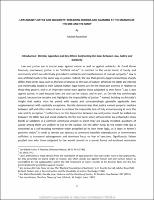Please use this identifier to cite or link to this item:
https://hdl.handle.net/20.500.12202/10079| Title: | Law against justice and solidarity: Rereading Derrida and Agamben at the margins of the one and the many |
| Authors: | Rosenfeld, Michel Rosenfeld, Michel Goodrich, Peter |
| Keywords: | Agamben Derrida Law Justice artificial virtue solidarity |
| Issue Date: | 6-Sep-2017 |
| Publisher: | Fordham University Press. |
| Citation: | Rosenfeld, M. (2019). Law against justice and solidarity: Rereading Derrida and Agamben at the margins of the one and the many. In P. Goodrich & M. Rosenfeld (Eds.), Economies of interpretation (pp. 54-102). New York, NY: Fordham University Press. |
| Series/Report no.: | Cardozo School of Law: Faculty Publications;2017 |
| Abstract: | Law and justice are in crucial ways against nature as well as against solidarity. As David Hume famously proclaimed, justice is an “artificial virtue” in contrast to the social bonds of family and community which are affectively grounded in solidarity and manifestations of mutual sympathy. Law is also artificial much in the same way as justice. Indeed, to the extent that law is conceived as a self-standing normative order propelled by its own inner logic, it tends to remain too abstract to command heartfelt internalization or commitment. Moreover, law often stands against justice as some laws are unjust and law can rarely if ever deliver full justice. The above insights pose difficult questions for proponents of critical jurisprudence and the respective contributions to legal theory by Derrida and Agamben enrich the debate and open fruitful perspectives in relation to the relation between law, justice and solidarity in the context of the nexus between the singular, the universal and the plural. For Derrida, law must pursue justice, but always falls short as there is tragically no way to ever reconcile the universal and the singular. For Agamben, in contrast, while reconciling law, justice and solidarity may be as elusive as it is for Derrida, it becomes masked by a ceremonial spectacle of religiously inspired mysterious harmony leading to consensus acclamation by those subjected to law combined with an unbridgeable gap between law and administration. This chapter places in context and compares Derrida’s deconstruction of law with Agamben’s reconstruction and inquires whether these two theorists complement one another and whether there are any solutions to the problems they confront that may open a way beyond despair or artifice. Suggested Citation: |
| Description: | Scholarly article / Open access |
| URI: | https://papers.ssrn.com/sol3/papers.cfm?abstract_id=3030448 https://hdl.handle.net/20.500.12202/10079 |
| ISBN: | 978-0-8232-8381-1 |
| Appears in Collections: | Benjamin N. Cardozo School of Law: Faculty Publications |
Files in This Item:
| File | Description | Size | Format | |
|---|---|---|---|---|
| Rosenfeld (2019) Law against justice.pdf | 849.01 kB | Adobe PDF |  View/Open |
This item is licensed under a Creative Commons License

